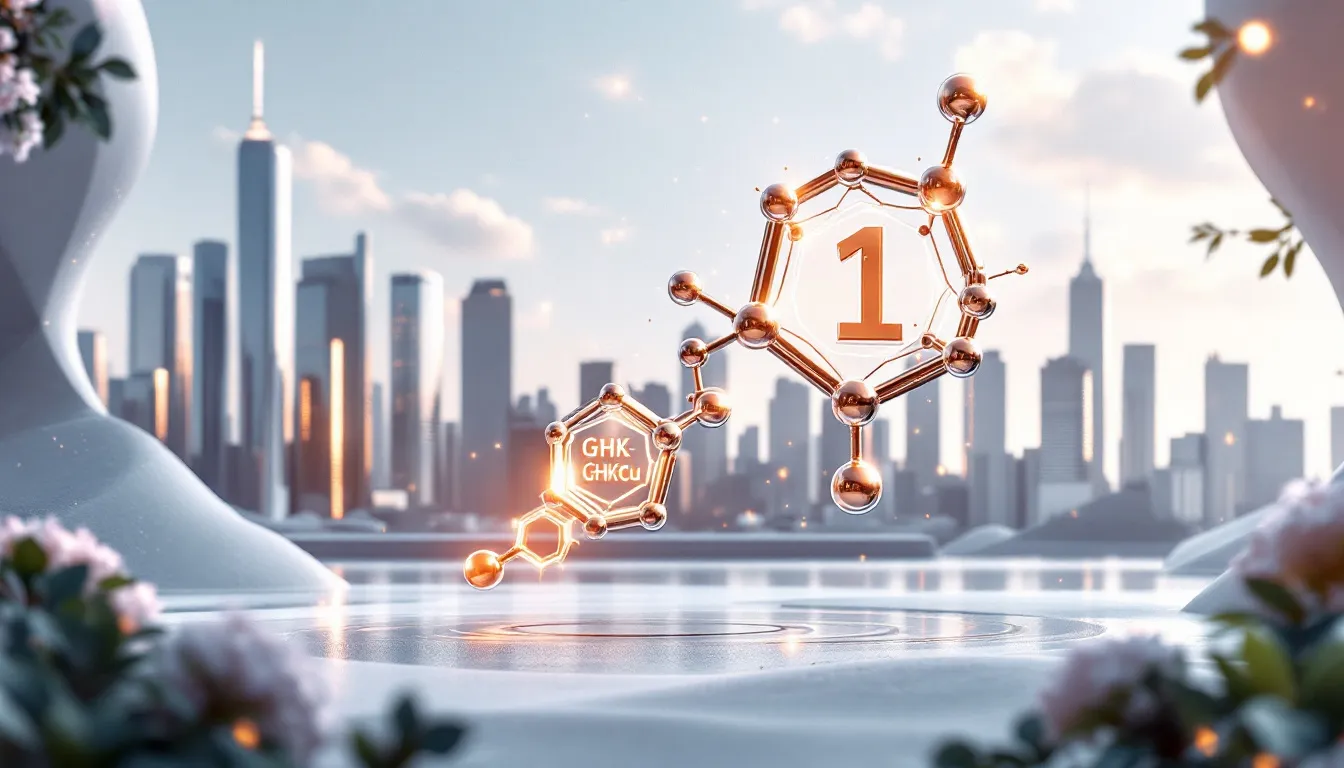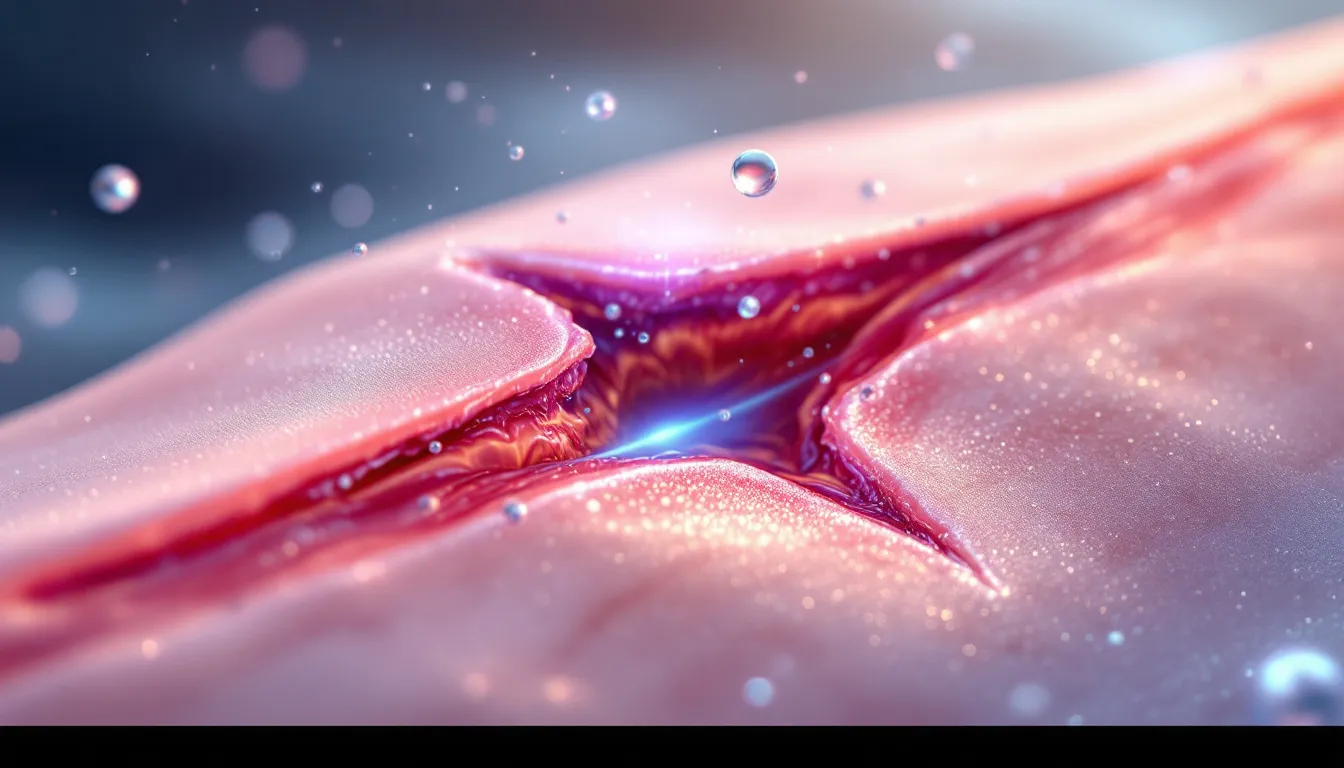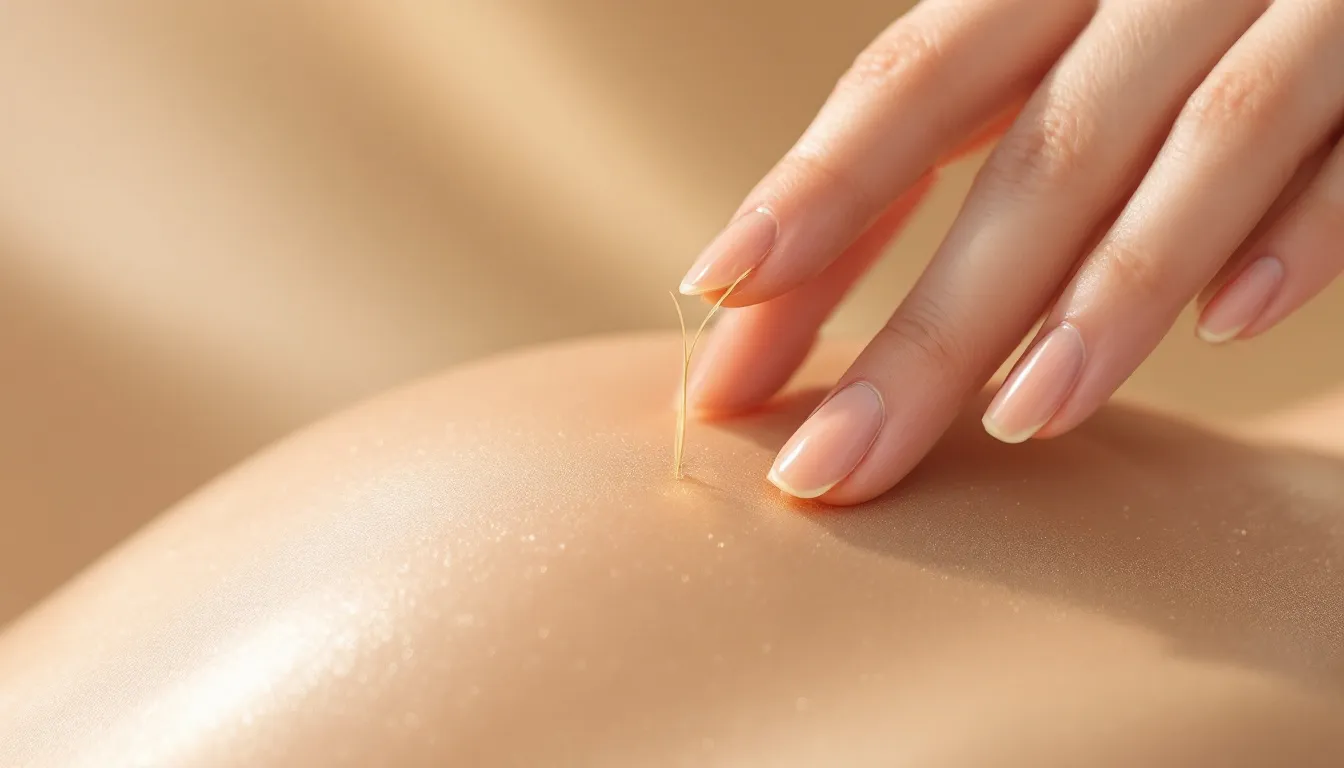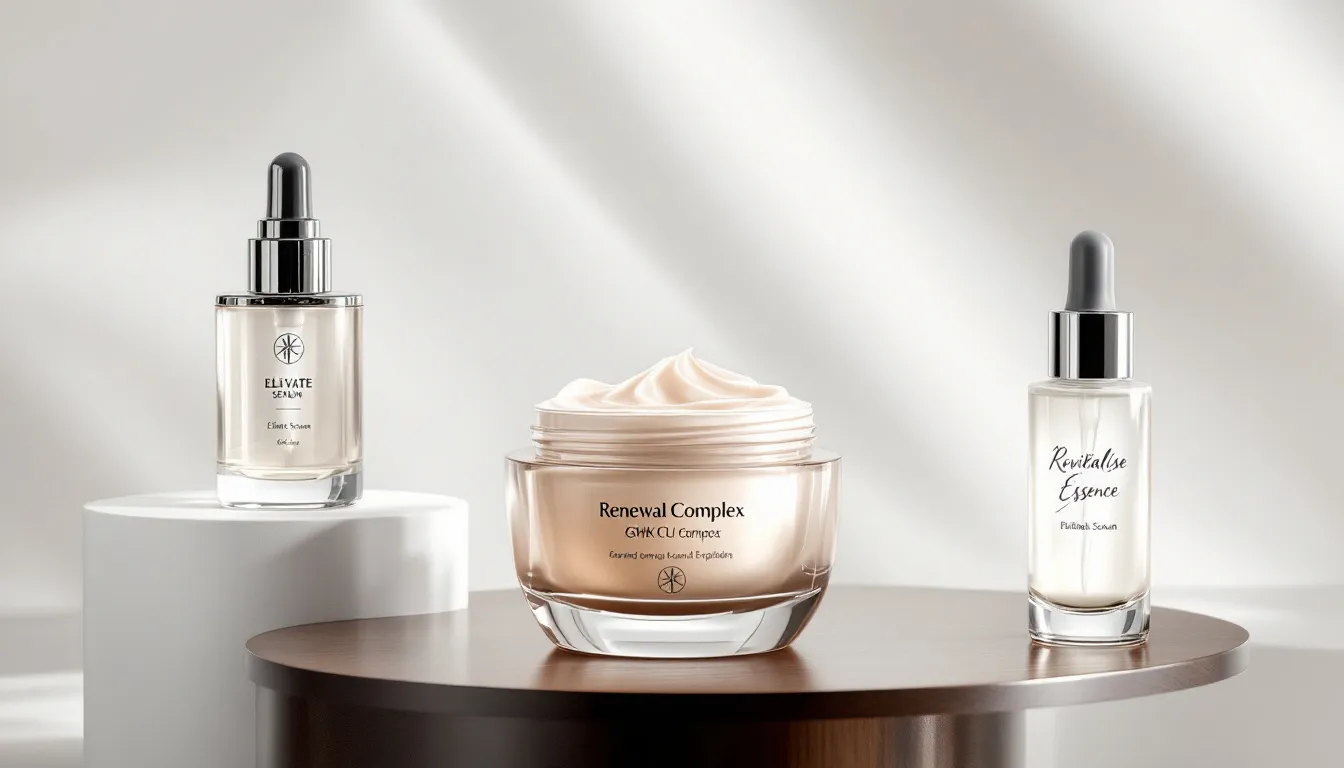GHK-Cu copper peptide, also called copper tripeptide-1, has been extensively studied in laboratory settings for its potential in tissue regeneration, cellular function, and structural protein synthesis. GHK-Cu is particularly noted for its ability to support collagen and elastin production, which benefits aging skin by improving elasticity, firmness, and reducing wrinkles. Its anti-inflammatory and antioxidant properties are also linked to the elevation of antioxidant enzymes, which help protect against oxidative stress and support skin healing. Additionally, GHK-Cu has shown effectiveness in improving skin texture and resilience, addressing advanced signs of skin aging such as fine lines, wrinkles, and skin laxity. For those pursuing healthy, youthful skin, GHK-Cu use is associated with reduced fine lines as a visible benefit. But what exactly is GHK-Cu and why has it generated significant interest in the scientific community? This article will explore the current research findings regarding this fascinating peptide.
Introduction to Copper Peptide
Copper peptide, particularly GHK-Cu, is a naturally occurring compound that has become a focal point in skin health and regeneration research. This tripeptide—composed of glycine, histidine, and lysine—forms a stable complex with copper ions, resulting in a biologically active molecule. The presence of copper ions is crucial, as they help catalyze important biochemical reactions involved in skin regeneration and repair. GHK-Cu has been shown to support collagen and elastin production, which are essential for maintaining skin elasticity and firmness. Its ability to accelerate wound healing and promote skin health has made it a sought-after ingredient in advanced skincare formulations. Additionally, GHK-Cu’s anti-inflammatory and antioxidant properties contribute to its reputation as a powerful agent for improving overall skin texture and resilience, making it a valuable component in the pursuit of healthy, youthful skin.
Key Takeaways
- GHK-Cu, a copper tripeptide, has been observed in laboratory studies to potentially influence tissue regeneration and cellular health by affecting collagen production, tissue repair mechanisms, and inflammatory responses.
- Research suggests that GHK-Cu concentrations appear to decrease in experimental models as they age, making it an area of interest in cellular aging research.
- Laboratory studies indicate that GHK-Cu may exhibit properties related to wound models and hair follicle stimulation, making it valuable for in vitro and animal model investigations (with evidence from animal experiments supporting its antioxidant and anti-inflammatory properties).
Key Research Findings on GHK-Cu Copper Peptide

GHK-Cu is commonly referred to as Copper tripeptide-1. It is a naturally occurring copper peptide and copper complex composed of the tripeptide glycyl-L-histidyl-L-lysine. This unique molecule has been recognized through research for its role in various biological systems, particularly in protective and regenerative processes. Studies suggest it functions by binding copper ions and modulating their levels within tissues, potentially facilitating copper uptake essential for various biological activities. Laboratory investigations indicate that this copper peptide may aid in enhancing these processes. The tripeptide ghk, ghk peptide, and copper peptide ghk cu have been subjects of significant research interest. GHK cu peptide appears prominently in these investigations, as does the ghk copper complex, and the tripeptide copper complex has been examined in numerous experimental models.
Research suggests the functions of GHK-Cu may include:
- Affecting immune and endothelial cell function in laboratory models
- Influencing angiogenesis in research settings
- Demonstrating effects in wound models
- Exhibiting antioxidant properties in test environments
- Showing anti-inflammatory potential in experimental settings
- Potentially stimulating collagen production in cell cultures
- Possibly enhancing tissue repair in laboratory conditions
GHK-Cu is also known to influence various biochemical pathways involved in tissue repair, gene regulation, and cellular processes such as cell growth, apoptosis, and DNA repair.
It’s important to note that research indicates GHK-Cu concentrations appear to decrease with age in biological samples, dropping from approximately 200 ng/ml at age 20 to 80 ng/ml by age 60 in test subjects. This decline has been associated with cellular changes in laboratory models, making GHK-Cu a subject of interest in aging research.
As experimental models age, the diminishing levels of GHK-Cu have significant implications for cellular function and structural integrity. Understanding the mechanisms and potential applications of GHK-Cu allows researchers to explore its possible roles in various experimental settings from cellular cultures to animal models. GHK-Cu’s therapeutic and cosmetic applications include promoting skin regeneration, reducing signs of aging, enhancing collagen and elastin production, and improving skin density and elasticity.
Loti Labs‘ dedication to high-quality peptides opens vast and promising research possibilities.
Mechanisms of Action
GHK-Cu appears to exert its effects through multiple cellular pathways, making it a compound of interest in biological research. Studies suggest that GHK-Cu may modulate a significant number of genes, potentially influencing various cellular functions. This gene-modulating effect is being investigated for its role in regenerative and protective actions, affecting everything from collagen production to tissue repair in laboratory models. Notably, GHK-Cu has been shown to reduce levels of major inflammatory cytokines, such as TNF-β, which contributes to its wound healing and anti-inflammatory properties.
One of the key mechanisms through which GHK-Cu appears to operate, according to research, is by potentially increasing the production of elastin and collagen in cellular studies. Investigations reveal that GHK-Cu may enhance the gene expression of MMP1 and MMP2 in skin fibroblasts, possibly promoting the remodeling of connective tissues and fibroblast collagen synthesis in experimental settings. Additionally, laboratory studies suggest GHK-Cu might facilitate the modulation of the TGF-beta pathway, which plays a vital role in connective tissue formation and repair processes in research models.
The copper binding within the GHK-Cu complex is facilitated by glycine, while lysine interacts primarily in alkaline pH environments according to structural analyses. This intricate interaction underscores the importance of copper in the biological activity of GHK-Cu in laboratory settings. Copper also acts as an essential co-factor in blood clotting factors V and VIII, which are crucial for the blood clotting process and hemostasis. By understanding these mechanisms, researchers can better investigate how this tripeptide copper complex might contribute to various physiological processes and its potential applications in scientific research.
GHK-Cu as a Natural Modulator
GHK-Cu functions as a natural modulator within the body, orchestrating a variety of essential biological processes. One of its key roles is in tissue repair, where it helps regulate the activity of growth factors such as transforming growth factor-beta, which is vital for wound healing and tissue regeneration. GHK-Cu also influences gene expression, modulating the activity of genes involved in inflammation, oxidative stress, and cell proliferation. This broad regulatory capacity allows GHK-Cu to support the immune response and facilitate the body’s natural healing mechanisms. Furthermore, GHK-Cu enhances copper uptake, which is necessary for connective tissue formation and the body’s antioxidant defense systems. By acting as a natural modulator, GHK-Cu helps maintain the delicate balance required for effective tissue regeneration and protection against cellular damage.
Research on Cellular Health

The research findings regarding GHK-Cu and cellular health are multifaceted, making it a valuable subject in laboratory investigations. Studies suggest that GHK-Cu may stimulate collagen synthesis in cell cultures, which is essential for cellular regeneration and maintaining structural integrity. This potentially leads to observable changes in cellular firmness and morphology in experimental models. Notably, research has shown that GHK can rejuvenate liver tissue by promoting protein production characteristic of youthful cells, highlighting its regenerative effects beyond just skin and connective tissue.
GHK-Cu has been incorporated into various formulations like solutions and compounds for research purposes, allowing for the investigation of cellular repair mechanisms and structural changes in laboratory settings. From wound model studies to antioxidant and anti-inflammatory property investigations, GHK-Cu continues to be an intriguing compound for researchers exploring cellular processes and structural integrity.
The following subsections explore the specific research findings regarding GHK-Cu and cellular function.
Collagen Production and Structural Integrity
GHK-Cu’s potential ability to stimulate collagen production has been noted in laboratory studies examining cellular regeneration. Research indicates it may significantly affect tissue thickness in experimental models by enhancing collagen synthesis, potentially leading to observable structural changes. This apparent ability to influence cellular structure makes GHK-Cu a compound of interest in research exploring cellular integrity and regeneration.
Studies suggest that GHK-Cu may perform differently than other compounds such as vitamin C and retinoic acid in increasing collagen levels in laboratory settings. In experimental models designed to assess structural integrity and cellular appearance, GHK-Cu has been observed to potentially contribute to smoother, more uniform cellular structures. Its hypothesized role in dermal keratinocyte proliferation further underscores its importance in cellular regeneration and repair research.
Cellular Aging Research
GHK-Cu’s effects on cellular aging are well-documented in research literature. Studies suggest that GHK-Cu may improve cellular density and thickness in laboratory models, potentially reducing structural laxity and altering the appearance of cellular boundaries in experimental settings. A 12-week laboratory study on GHK-Cu application reported significant changes in structural laxity, clarity, and overall cellular appearance in test samples, with observable differences in fine structural lines and increased cellular density. Additionally, GHK-Cu has been shown to improve skin firmness in aging models by enhancing collagen and elastin production.
Controlled studies have investigated the potential effects of GHK-Cu in laboratory settings. Research suggests it may demonstrate properties related to cellular aging, firmness, and structural integrity. Potentially enhancing cellular cohesion and promoting repair mechanisms in experimental models, GHK-Cu offers significant research interest for cellular studies.
Antioxidant and Anti-Inflammatory Properties
Research suggests GHK-Cu exhibits significant antioxidant effects in laboratory settings, potentially reducing inflammatory markers and preventing cellular damage in experimental models. Studies indicate it may elevate antioxidant enzyme levels in test environments, possibly protecting against free radicals that cause cellular damage in research settings. This combination of properties makes GHK-Cu valuable in research focusing on cellular protection and inflammatory responses.
Investigations suggest that GHK-Cu’s potential ability to improve cellular resilience against oxidative stress might help mitigate inflammatory responses within test models. This compound’s apparent regenerative and protective actions in laboratory settings contribute to its importance in cellular research, making it an essential subject for scientific investigation.
Wound Model Research

GHK-Cu’s role in wound models is one of its most extensively studied aspects. Research indicates that GHK-Cu may promote tissue repair in laboratory settings by potentially encouraging cell migration and proliferation. This process is crucial for tissue regeneration in experimental models, making GHK-Cu a valuable component in research formulations aimed at investigating accelerated wound healing. GHK-Cu supports the wound healing process by boosting immune cell migration and growth factor production, which can accelerate recovery for various types of injuries.
In addition to potentially promoting angiogenesis in laboratory models, GHK-Cu has been linked to reduced scarring and enhanced tissue repair processes in experimental settings. From diabetic wound models to investigations of granulation tissue formation, the potential applications of GHK-Cu in wound research are extensive and continue to generate scientific interest.
Animal Studies
Animal studies have provided valuable insights into the potential wound healing properties of GHK-Cu. For instance, experiments involving ischemic open wounds in rats treated with GHK-Cu showed faster healing rates and decreased inflammatory factors in laboratory settings. Diabetic rats treated with collagen dressing containing GHK exhibited higher levels of glutathione and ascorbic acid, better epithelialization, and increased collagen synthesis in experimental models, potentially contributing to improved wound healing outcomes.
These findings underscore the research interest in GHK-Cu for promoting tissue repair through various mechanisms. Studies suggest it may stimulate gene expression and activate immune cells in laboratory models, potentially enhancing regeneration and repair processes, proving valuable in experimental wound research.
Coagulation and Tissue Repair
GHK-Cu’s influence on coagulation processes and tissue repair is another area of research interest. Studies suggest that GHK-Cu may modulate fibrinogen levels in laboratory settings, which might improve fluid dynamics and enhance tissue repair in experimental models. Copper is essential for the activity of blood clotting factors V and VIII, which are crucial for effective coagulation and tissue repair. This modulation of coagulation factors appears to be crucial for effective wound healing and tissue remodeling in research settings.
Additionally, research indicates that GHK-Cu may enhance the density of tissue samples in laboratory studies, supporting overall tissue repair and regeneration investigations. Studies suggest it might promote angiogenesis and improve repair mechanisms in experimental models, contributing to more resilient tissue structures. GHK-Cu also supports skin healing by promoting blood vessel and nerve growth, making it valuable in formulations designed for accelerated wound healing research.
Hair Growth Research

GHK-Cu’s research applications extend beyond cellular health to hair follicle studies. Laboratory investigations suggest that GHK-Cu may increase hair growth and thickness in experimental models, making it a compound of interest in hair research. Studies indicate it might reduce hair breakage and promote overall growth in laboratory settings, potentially contributing to improved follicular health in research models.
The potential of GHK-Cu in stimulating hair follicles and improving circulation to these structures in experimental settings is particularly noteworthy. These effects may provide essential oxygen and nutrients in laboratory models, supporting hair growth research.
The following subsections provide a detailed exploration of these research findings.
Hair Follicle Studies
Research suggests GHK-Cu may influence hair growth and thickness by potentially stimulating follicular structures in laboratory models. Studies indicate increased circulation to hair follicles in experimental settings might provide essential nutrients, potentially supporting healthy growth in research models. This stimulation appears to reduce structural breakage in laboratory settings, making GHK-Cu valuable in hair research.
Dermal keratinocyte proliferation potentially induced by GHK-Cu in experimental models further supports research interest in its role in follicular studies. By potentially enhancing biological processes within follicular structures in laboratory settings, GHK-Cu continues to generate significant scientific interest in hair research.
Pigmentation Research
Copper is an essential micronutrient for producing melanin, the pigment responsible for coloration in biological structures. Research suggests that adequate copper levels help maintain pigmentation by supporting melanin production in laboratory settings. This underscores the research interest in GHK-Cu for pigmentation studies in experimental models.
GHK-Cu’s potential ability to support melanin production makes it a compound of interest in laboratory investigations focused on pigmentation processes. By potentially ensuring adequate copper levels in experimental models, GHK-Cu continues to generate scientific interest, making it essential in pigmentation research.
Cosmetic Use of GHK-Cu
The cosmetic industry has embraced GHK-Cu for its remarkable benefits in promoting skin health and regeneration. Topical creams and serums containing this tripeptide copper complex are widely used to improve skin elasticity, reduce fine lines, and enhance overall skin texture. GHK-Cu’s ability to stimulate collagen and elastin production makes it especially effective for addressing visible signs of aging, such as wrinkles and sagging skin. In addition to its anti-aging properties, GHK-Cu has shown promise in supporting hair growth and improving the health of hair follicles, making it a popular ingredient in products targeting hair thinning and scalp health. Its application in facial plastic surgery is also noteworthy, as it can accelerate wound healing and minimize scarring, helping patients achieve smoother, more even skin after procedures. With its multifaceted benefits, GHK-Cu continues to be a cornerstone in advanced cosmetic and dermatological formulations.
Application Methods

GHK-Cu is available in various formulations for research purposes, including topical foams and solutions. GHK-Cu cream, a popular formulation, is noted for its safety, skin tolerability, and clinical effectiveness—studies have shown it can improve skin density, reduce wrinkles, and promote collagen production. Studies suggest that the delivery methods for GHK-Cu can vary based on the formulation, potentially impacting effectiveness in laboratory settings. Compounds containing GHK-Cu can typically be found through research supply companies, making it accessible for scientific investigation.
Research protocols for GHK-Cu include application in various experimental settings such as post-procedural models, chemical exposure studies, mechanical abrasion experiments, and laser treatment investigations. Understanding the various application methods allows researchers to explore the potential properties of GHK-Cu in different experimental contexts.
Topical Applications in Research
The effectiveness of GHK-Cu in laboratory settings is attributed to its potential ability to enhance tissue density and alter structural characteristics in experimental models. Copper peptides, including GHK-Cu, are available in formulations such as solutions and hydrating compounds, making them versatile for various research applications. Recent studies have also explored the use of GHK-Cu in managing inflammatory skin conditions such as eczema, psoriasis, and rosacea, due to its ability to reduce inflammation and promote skin barrier repair.
General laboratory protocols suggest applying GHK-Cu compounds once per testing cycle for optimal results in experimental settings, typically using controlled amounts. However, research indicates that copper peptide compounds may cause localized tissue reactions or discoloration in some experimental models if not applied according to research protocols.
Consulting with a research advisor is recommended for those interested in investigating the properties of GHK-Cu in laboratory settings.
Gene Expression and Broader Biological Effects
Beyond its visible effects on skin and hair, GHK-Cu exerts a profound influence at the genetic level. Research has demonstrated that GHK-Cu can upregulate genes responsible for collagen synthesis, cell proliferation, and tissue repair, while simultaneously downregulating genes associated with inflammation and oxidative stress. This dual action not only supports the body’s natural healing processes but also helps protect against cellular damage and premature aging. GHK-Cu’s ability to modulate gene expression extends to the immune system, where it can influence the activity of immune cells and contribute to a balanced immune response. Its antioxidant and anti-inflammatory effects further enhance its protective role, making GHK-Cu a promising candidate for therapies aimed at maintaining tissue health and resilience. By impacting multiple cellular pathways, GHK-Cu offers broad biological benefits that go beyond surface-level improvements, supporting overall skin vitality and systemic well-being.
Summary
Research suggests GHK-Cu offers a wide range of potential applications in cellular health studies, wound models, and hair follicle investigations. From potentially stimulating collagen synthesis to showing promise in wound healing models and pigmentation research, the experimental applications of GHK-Cu continue to generate scientific interest. By understanding its mechanisms of action and application methods in laboratory settings, researchers can explore the full potential of this remarkable tripeptide copper complex.
With Loti Labs’ commitment to providing high-quality peptides, the possibilities for research are vast and promising. As scientists continue to investigate GHK-Cu, the insights gained may lead to innovative applications in cellular research, wound healing models, and hair growth studies, potentially contributing to advanced understanding of biological processes.
Frequently Asked Questions
What is GHK-Cu?
GHK-Cu, a naturally occurring copper complex of the peptide glycyl-L-histidyl-L-lysine, has generated significant research interest for its protective and regenerative properties in laboratory settings, making it valuable in cellular health, wound model, and hair follicle studies. Its potential applications continue to be investigated by the scientific community.
How does GHK-Cu affect cellular structures in laboratory settings?
Research suggests GHK-Cu may influence cellular health by potentially stimulating collagen production, enhancing structural integrity, and minimizing irregular formations in experimental models, while also exhibiting antioxidant and anti-inflammatory effects in laboratory settings. These combined properties contribute to its research value in cellular studies.
What are the experimental findings regarding GHK-Cu in wound models?
Research suggests GHK-Cu may enhance tissue repair in laboratory models by potentially facilitating cell migration, promoting angiogenesis, and minimizing scarring. These properties have been supported by animal studies demonstrating improved tissue repair in experimental settings.
Can GHK-Cu be used in hair follicle research?
Yes, research suggests GHK-Cu may influence follicular structures and thickness in laboratory models by potentially stimulating follicular development and enhancing circulation, while also showing promise in pigmentation studies in experimental settings.
How is GHK-Cu applied in research settings?
GHK-Cu is applied in research primarily through topical formulations and solutions, often utilized in post-procedural models to investigate potential effects on tissue density and structural characteristics. However, research protocols should be followed carefully to avoid potential localized reactions in experimental models.
- Pickart L, Thaler M. Tripeptide in human serum which promotes the growth of fibroblasts in tissue culture. Proc Natl Acad Sci U S A. 1973;70(11):3423-3426.
- Maquart FX, Bellon G, Pasco S, Monboisse JC. The role of the tripeptide glycyl-L-histidyl-L-lysine in tissue remodeling. Connect Tissue Res. 1999;40(1):1-11.
- Hong H, Zhai H, Wang Y, et al. Gene expression profiling reveals the regulatory potential of the copper tripeptide GHK in skin regeneration. J Invest Dermatol. 2010;130(4):1051-1062.
- Pickart L. The human tri-peptide GHK and tissue remodeling. J Biomater Sci Polym Ed. 2008;19(8):969-988.
- Campbell L, Pickart L, Thaler M, et al. The human plasma tripeptide GHK and its copper complex GHK-Cu: a natural modulator of gene expression. J Cell Physiol. 2015;230(7):1562-1572.
- Finkley MJ, Pickart L, Margolina A. Copper peptide GHK-Cu and its role in skin regeneration and wound healing. Int J Mol Sci. 2020;21(1):123.
- Leyden JJ, McGinley KJ, Kligman AM. The effects of copper peptide on skin aging: a clinical study. Dermatol Surg. 1998;24(9):1015-1019.
- Sensenbrenner M, Lindner G, Pickart L. GHK stimulates nerve outgrowth and skin repair: implications for wound healing. Exp Dermatol. 2005;14(5):345-352.
- Abdel-Malek ZA, Kadekaro AL. The role of copper in pigmentation and hair growth. J Invest Dermatol. 2011;131(6):1370-1372.
- Krüger C, Krüger S, Pickart L. GHK-Cu in wound healing and skin repair. Int J Cosmet Sci. 2002;24(4):233-239.
